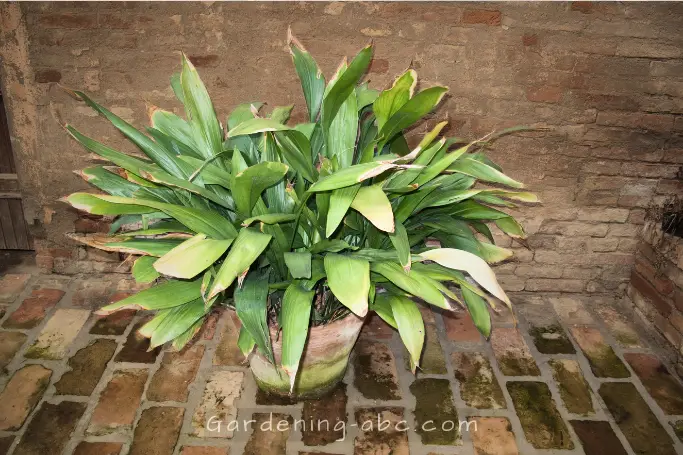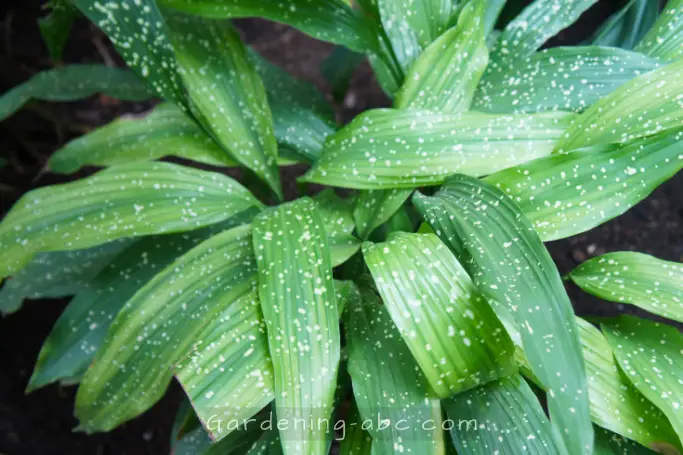We use affiliate links to run our site. When you buy through links on our site, we may earn an affiliate commission, without any added cost to you. Learn more
Do you want a plant that can grow almost anywhere, even in the dark? Do you want a plant that doesn’t need much attention, but still looks beautiful and healthy? If you answered yes, then you might want to consider the cast iron plant.
This amazing plant is one of the toughest and most adaptable plants you can find. It comes from East Asia, where it has learned to survive in harsh environments. It has dark green leaves that add a touch of elegance to any space.
In this article, you will learn how to grow and care for a cast iron plant, and discover why it is such a great choice for indoor and outdoor gardening.
What is a Cast Iron Plant?
The cast iron plant, scientifically known as Aspidistra elatior, is a member of the Asparagaceae family. It features long, arching leaves that grow directly from the soil, reaching up to 2 feet in length.
It has dark green, glossy leaves that can grow up to 50 cm long, and small, cream-colored flowers that appear near the base of the plant.
It is native to Japan and Taiwan, and it is widely grown as a houseplant because of its ability to tolerate low light, low humidity, and irregular watering.
The plant’s common name, “cast iron,” reflects its ability to withstand adverse conditions such as low light, low humidity, and neglect.
Benefits of Growing a Cast Iron Plant at Home
There are several benefits to growing a cast iron plant in your home:
- Air purification: Cast iron plants are known for their ability to filter and purify indoor air by removing harmful toxins.
- Low light tolerance: Cast iron plants can thrive in areas with minimal natural light, making them suitable for rooms with limited sunlight.
- Low maintenance: These plants require minimal care and attention, making them perfect for busy individuals or those new to gardening.
- Drought tolerance: Cast iron plants can tolerate periods of drought, making them ideal for individuals who tend to forget regular watering.
Choosing the Right Location
Before bringing a cast iron plant into your home, it’s crucial to select the right location based on your indoor or outdoor conditions.
Indoor Conditions
- Low-light areas: Cast iron plants are ideal for areas with low-light conditions, such as hallways, corners, or rooms with north-facing windows.
- Avoid direct sunlight: While the cast iron plant can tolerate low light, it is best to avoid placing it in direct sunlight, as it can scorch the leaves.
Outdoor Conditions
- Shade to part-shade: In outdoor settings, cast iron plants thrive in shaded or partially shaded areas, such as under trees or on covered patios.
Protection from extreme temperatures: Ensure the plant is protected from extreme heat and cold temperatures, as they can negatively impact the plant’s health.
Selecting the Ideal Pot

When choosing a pot for your cast iron plant, consider the following factors:
- Size: Select a pot that allows for the plant’s growth, with enough room for the roots to spread.
- Drainage: Ensure the pot has drainage holes to prevent waterlogged soil, as cast iron plants prefer slightly moist but well-draining soil.
- Material: Opt for a sturdy pot made of ceramic, terracotta, or plastic, as these materials retain moisture and provide stability. They all have their pros and cons so select the one that suits your requirements.
Soil Requirements
Providing the right soil conditions is crucial for the successful growth of your cast iron plant. Here’s what you need to know:
- Well-draining soil: Use a well-draining potting mix that allows excess water to escape, preventing root rot.
- Organic matter: Add organic matter, such as compost or peat moss, to improve soil fertility and moisture retention.
- Acidic to neutral pH: Cast iron plants prefer slightly acidic to neutral soil, with a pH range between 6.0 and 7.0. Check the current pH of your soil and then adjust accordingly.
You may have to increase or decrease the pH. Use the following guideline:
Watering and Humidity Needs
Proper watering and humidity levels are essential for the health of your cast iron plant. Follow these guidelines:
- Moderate watering: Water your cast iron plant when the top inch of soil feels slightly dry. Avoid overwatering, as it can lead to root rot.
- Allow drainage: Ensure the pot has proper drainage to prevent water from accumulating at the bottom.
- Mist the leaves: Cast iron plants appreciate higher humidity levels. Mist the leaves occasionally or place the pot on a tray filled with water and pebbles to increase humidity.
Alternatively, you can also use a humidifier like this to increase the overall humidity of the surrounding environment.
Providing Adequate Light
While cast iron plants tolerate low light conditions, they still require some indirect light for optimal growth. Consider the following:
- Indoor lighting: Place your cast iron plant near a north or east-facing window to provide it with bright, indirect light.
- Avoid direct sunlight: Direct sunlight can scorch the leaves, so it’s best to keep your plant away from intense sunlight.
Temperature Considerations
Cast iron plants are adaptable to a wide range of temperatures but prefer moderate conditions. Consider the following temperature guidelines:
- Indoor temperatures: Maintain temperatures between 60°F (15°C) and 75°F (24°C) for optimal growth.
- Outdoor temperatures: Cast iron plants can tolerate outdoor temperatures between 50°F (10°C) and 85°F (29°C), but it’s best to protect them from extreme heat or cold.
Fertilizing The Plant
Fertilizing your cast iron plant can help promote healthy growth. Follow these fertilization tips:
- Slow-release fertilizer: Apply a balanced, slow-release fertilizer during the growing season, following the package instructions.
- Diluted liquid fertilizer: Alternatively, you can use a diluted liquid fertilizer every two to three weeks during the growing season.
Pruning and Propagation Techniques
Pruning and propagating your cast iron plant can help maintain its shape and expand your plant collection. Here are some techniques to consider:
Pruning:
To keep it healthy and attractive, you need to prune any damaged or yellowing leaves regularly.
- Remove dead or yellowing leaves: Regularly inspect your plant and remove any dead or yellowing leaves to maintain their appearance.
- Trim leggy growth: If your cast iron plant becomes leggy, you can trim back the long stems to encourage bushier growth.
Propagation
Here are some ways to propagate the cast iron plant:
Propagation by division:
Carefully lift the plant out of its pot and gently separate the rhizomes into smaller sections, each with at least one leaf and some roots.
Replant the divisions in fresh potting mix and water them thoroughly. Place them in a bright spot with indirect light and keep the soil moist but not soggy until new growth appears.
Propagation by cuttings:
You can also propagate your cast iron plant by taking stem cuttings. Select a healthy stem and cut it just below a node. Remove the lower leaves and place the cutting in a pot with a moist potting mix.
Check the soil regularly and water as needed to keep it moist but not wet. After a few weeks, you should see new roots forming at the base of the leaf.
Common Pests and Diseases
While cast iron plants are generally hardy, they can still be susceptible to certain pests and diseases. Be on the lookout for:
- Spider mites: These tiny pests can cause yellowing and stippling on the leaves. Use insecticidal soap or neem oil to control infestations.
- Mealybugs: Mealybugs can leave a white, cotton-like substance on the plant. Remove them manually or use insecticidal sprays.
- Root rot: Overwatering can lead to root rot. Ensure proper drainage and adjust watering accordingly.
- Leaf spot: Fungal diseases like leaf spots can occur if the plant is exposed to excessive moisture. Avoid overhead watering and improve air circulation around the plant.

Troubleshooting Tips
If you encounter any issues with your cast iron plant, consider these troubleshooting tips:
- Yellow leaves: Yellowing leaves may indicate overwatering or insufficient light. Adjust your watering routine and ensure adequate light exposure.
- Brown tips: Brown tips can be a sign of underwatering or low humidity. Increase the watering frequency and consider misting the leaves.
- Stunted growth: If your cast iron plant isn’t growing as expected, review its care routine. Check for proper light, watering, and fertilization.
Can I keep a Cast Iron Plant in a dark corner of my home?
Yes, cast iron plants can thrive in low light conditions, making them suitable for dark corners or rooms with minimal natural light.
How often should I water my Cast Iron Plant?
Water your cast iron plant when the top inch of the soil feels slightly dry. It’s important not to overwater, as these plants prefer slightly moist but well-draining soil.
Can I use tap water to water my Cast Iron Plant?
Tap water is generally fine for watering cast iron plants. However, if your tap water contains high levels of chlorine or fluoride, consider using filtered or distilled water.
How tall does a Cast Iron Plant typically grow?
Cast iron plants can reach a height of around 2 feet, but growth rates can vary depending on the conditions and care provided.
Can I grow a Cast Iron Plant outdoors in a colder climate?
Cast iron plants are typically grown as indoor plants or in mild climates. They are not frost-tolerant and may suffer damage in colder temperatures. It’s best to grow them indoors.
Conclusion
Cast iron plants are truly remarkable plants that can add beauty and charm to your home. They are easy to grow and take care of, and they can survive in almost any condition.
If you want to learn more about cast iron plants or other houseplants, you can explore our website for more articles and resources.
You can also share this post with your friends and family who might be interested in cast iron plants.
And don’t forget to take action: get yourself a cast iron plant today and enjoy its benefits for years to come!
Amazon and the Amazon logo are trademarks of Amazon.com, Inc, or its affiliates.

Hi there! My name is Prasenjit and I’m an avid gardener and someone who has grown a passion for growing plants. From my hands-on experience, I have learned what works and what doesn’t. Here I share everything I have learned.
